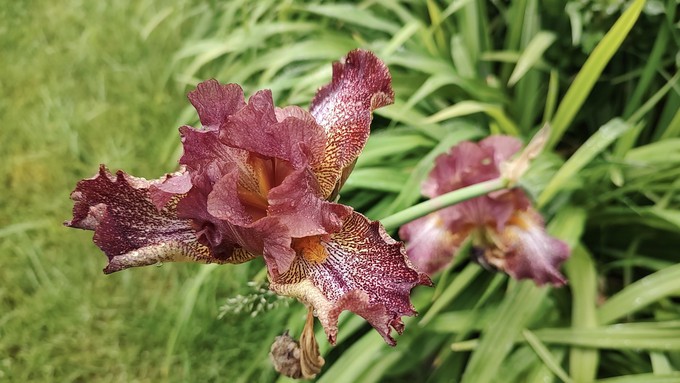
How to renew vigor of bearded iris, a perfect perennial for Sacramento

This bearded iris managed to poke out a bloom, but it's overcrowded by day lilies. Both are getting divided this month. Debbie Arrington
Did your bearded irises “forget” to bloom this year? It’s time to divide.
Bearded irises tend to overcrowd their rhizomes – their thick fleshy roots. Like writhing snakes, the rhizomes twist and turn over each other. If they get too crowded, they won’t bloom.
The more winter water they get, the more the rhizomes seem to grow. After last winter’s storms, my irises had quite a growth spurt. They produced loads of lush foliage, but scant blooms – because I hadn’t divided them lately.
In the Sacramento region, bearded irises should be divided every three to five years. If your bearded irises have not bloomed in more than a year (but still look relatively healthy), it’s time to dig them up.
Rhizomes also will grow right into walls or edging until they can’t grow any more. And it’s the new rhizome growth that produces bloom stems.
Native to the Mediterranean, southern Europe and Germany, bearded irises are ideal for Sacramento’s climate. They need almost no care and little water during our dry summer months. With a little TLC, they come back year after year.
Traditionally, August is the best time to divide and replant irises in Sacramento. With a slight break in the heat expected next week, now may be a good time to tackle your iris beds.
Start by digging up the main clump; some rhizomes will look old and withered. With a sharp clean knife, cut those off and discard.
The other segments can be cut or broken apart. Make sure there’s at least one “fan” of leaves on each segment to be replanted. Trim the leaves to about 4 to 6 inches long. If you know, write on the leaves the iris variety or color. (A Sharpie works well for this.) This helps keep them sorted when you replant – and when you share irises with friends.
You don’t have to divide irises every year, so a little extra effort when you do makes a lasting difference. Even though irises are planted very shallow, dig down at least 10 to 12 inches and work the soil, breaking up any large clumps. (This is especially important in heavy clay soils.) Spade in some well-aged compost and bone meal to promote big flowers and root development.
Irises appreciate good drainage and full sun. If your soil is heavy clay, add some coarse sand along with the compost and bone meal. Don’t use high-nitrogen fertilizers on irises; it promotes lots of leaves but no flowers.
To replant, form two parallel trenches with a ridge down the middle. Put the rhizomes on top of the ridge with their stringy roots running down into the trenches on either side. Space each rhizome about 12 to 18 inches apart.
The plants will grow (and rhizomes increase) in the direction the fans of leaves are pointing. Arrange the rhizomes so their fans are all pointing (at least generally) the same direction; that keeps them from overcrowding too quickly. If arranged in a circle, place the fans pointing away from the center.
Once placed, gently press the rhizomes into that ridge, making sure the top of the rhizomes will be just above soil level. Then, fill in the side trenches with soil.
Water deeply – and wait. The rhizomes will start producing fresh leaves in early fall. Water the plants occasionally so they don’t dry out, but otherwise leave them alone.
Remember to share some of those freshly dug irises with friends. One large clump can produce several new plants – many more than is needed to replant the same space. Those extra rhizomes should be replanted within two weeks. If not transplanted in the ground, those excess irises can be transplanted in pots. They’ll bloom – as long as their rhizomes have room.
For more on irises: www.irises.org.
Comments
0 comments have been posted.Sacramento Digs Gardening to your inbox.
Sites We Like
Garden Checklist for week of July 21
Your garden needs you!
* Keep your vegetable garden watered, mulched and weeded. Water before 8 a.m. to reduce the chance of fungal infection and to conserve moisture.
* Feed vegetable plants bone meal, rock phosphate or other fertilizers high in phosphate to stimulate more blooms and fruiting. (But wait until daily high temperatures drop out of the 100s.)
* Don’t let tomatoes wilt or dry out completely. Give tomatoes a deep watering two to three times a week.
* Harvest vegetables promptly to encourage plants to produce more. Squash especially tends to grow rapidly in hot weather. Keep an eye on zucchini.
* Pinch back chrysanthemums for bushy plants and more flowers in September.
* Remove spent flowers from roses, daylilies and other bloomers as they finish flowering.
* Pinch off blooms from basil so the plant will grow more leaves.
* Cut back lavender after flowering to promote a second bloom.
* It's not too late to add a splash of color. Plant petunias, snapdragons, zinnias and marigolds.
* From seed, plant corn, pumpkins, radishes, winter squash and sunflowers.